This is the current revision of this page, as edited by Entranced98 (talk | contribs) at 14:00, 29 November 2024 (Reverted edit by 95.97.2.202 (talk) to last version by ClueBot NG). The present address (URL) is a permanent link to this version.
Revision as of 14:00, 29 November 2024 by Entranced98 (talk | contribs) (Reverted edit by 95.97.2.202 (talk) to last version by ClueBot NG)(diff) ← Previous revision | Latest revision (diff) | Newer revision → (diff) Rice dish from the Valencian Community, Spain Not to be confused with paelya.
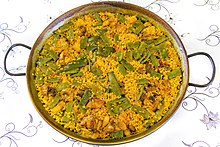 Valencian paella Valencian paella | |
| Course | Main course |
|---|---|
| Place of origin | Spain |
| Region or state | Valencia |
| Associated cuisine | Valencian cuisine, Spanish cuisine |
| Serving temperature | warm |
| Main ingredients | Short-grain rice, meats (chicken, rabbit) or seafood, vegetables, green beans, lima beans, saffron |
| Similar dishes | Paelya (in the Philippines), Fideuà |
Paella (/paɪˈɛlə/, /pɑːˈeɪjə/, py-EL-ə, pah-AY-yə, Valencian: [paˈeʎa]; Spanish: [paˈeʝa]) is a rice dish originally from the Valencian Community. Paella is regarded as one of the community's identifying symbols. It is one of the best-known dishes in Spanish cuisine.
The dish takes its name from the wide, shallow traditional pan used to cook the dish on an open fire, paella being the word for a frying pan in Valencian/Catalan language. As a dish, it may have ancient roots, but in its modern form, it is traced back to the mid-19th century, in the rural area around the Albufera lagoon adjacent to the city of Valencia, on the Mediterranean coast of Spain.
Paella valenciana is the traditional paella of the Valencia region, believed to be the original recipe, and consists of Valencian rice, olive oil, rabbit, chicken, saffron or a substitute, tomato, ferradura or flat green bean, lima beans (Phaseolus lunatus), salt and water. The dish is sometimes seasoned with whole rosemary branches. Traditionally, the yellow color comes from saffron, but turmeric and Calendula can be used as substitutes. Artichoke hearts and stems may be used as seasonal ingredients. Most paella cooks use bomba rice, but a cultivar known as senia is also used in the Valencia region.
Paella de marisco (seafood paella) replaces meat with seafood and omits beans and green vegetables, while paella mixta (mixed paella) combines meat from livestock, seafood, vegetables, and sometimes beans, with the traditional rice.
Other popular local variations of paella are cooked throughout the Mediterranean area, the rest of Spain, and internationally. In Spain, paella is traditionally included in restaurant menus on Thursdays.
History
Possible origins
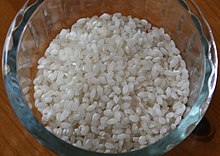
Muslims in Al-Andalus began rice cultivation around the 10th century. Consequently, eastern Iberian Peninsula locals often made casseroles of rice, fish, and spices for family gatherings and religious feasts, thus establishing the custom of eating rice in Spain. This led to rice becoming a staple by the 15th century. Afterward, it became customary for cooks to combine rice with vegetables, beans, and dry cod, providing an acceptable meal for Lent. Along Spain's Mediterranean coast, rice was predominantly eaten with fish.
Spanish food historian Lourdes March notes that the dish "symbolizes the union and heritage of two important cultures, the Roman, which gives us the utensil and the Arab which brought us the basic food of humanity for centuries: rice."
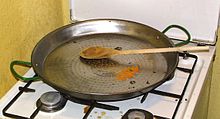
Naming, etymology and paellera
Paella is a Valencian word that means frying pan, from which the dish gets its name. Valencian speakers use the word paella for all pans, including the traditional shallow pan used for cooking the homonym dish. The pan is made of polished or coated steel with two side handles.
In many regions of Spain and other Spanish-speaking countries, the term paellera may be used for the traditional pan, while paella is reserved for the rice dish prepared in it. Both paella and paellera are correct terms for the pan.
According to the etymologist Joan Coromines, the Catalan word paella derives from the Old French word paelle for frying pan, which in turn comes from the Latin word patella for pan; he thinks that otherwise the word should be padella, as inter-vowel -d- dropping is not typical of Old Catalan.
The word paella is also related to paila used in many Latin American countries. Paila in Latin American Spanish refers to a variety of cookware resembling metal and clay pans, which are also used for both cooking and serving.
The Latin root patella from which paella derives is also akin to the modern French poêle, the Italian padella, and the Old Spanish padilla.
Some claim that the word paella comes from the Arabic بَقَايَا, pronounced baqaayya, meaning "leftovers." This claim is based on the 8th-century custom in which Moorish kings' servants would take home the rice, chicken, and vegetables their employers left at the end of the meal. It has been said, however, that a problem with this etymology is that the word paella is not attested until six centuries after Moorish Valencia was conquered by James I.
Paella valenciana
Originally, paella made in Valencia was a lunchtime meal for farmers and farm laborers. Workers would gather what was available to them around the rice fields. This often included tomatoes, onions, and snails. Rabbit or duck was a common addition, or chicken less often.
On special occasions, 18th-century Valencians used calderos to cook the rice in the open air of their orchards near lake Albufera. Water vole meat was one of the main ingredients of early paellas, along with eel and butter beans. Novelist Vicente Blasco Ibáñez described the Valencia custom of eating water voles in Cañas y Barro (1902), a realistic novel about life among the fishermen and peasants near lake Albufera.
Living standards rose with the sociological changes of the late 19th century in Spain, giving rise to gatherings and outings in the countryside. This led to a change in paella's ingredients, as well, using instead rabbit, chicken, duck, and sometimes snails. The dish became so popular that in 1840, a local Spanish newspaper first used the word paella to refer to the recipe rather than the pan, according to food historian Lynne Olver.
The most widely used, complete ingredient list of this era was: short-grain white rice, chicken, rabbit, snails (optional), duck (optional), butter beans, great northern beans, runner beans, artichoke (a substitute for runner beans in the winter), tomatoes, fresh rosemary, sweet paprika, saffron, garlic (optional), salt, olive oil, and water. Poorer Valencians sometimes used only snails for meat. Many Valencians insist that no more than these ingredients should go into making modern paella valenciana, and, in particular, that fish and shellfish are "absolutely out of the question." Another important rule, according to Valencians, is that fresh rosemary should not be added to paella valenciana made with rosemary-eating snails.
Seafood and mixed paella
On the Mediterranean coast, Valencian fishermen used seafood instead of meat and beans to make paella. In this recipe, the seafood is served in the shell. Later, Spaniards living outside of Valencia combined seafood with meat from land animals, and mixed paella was born. This paella is sometimes called preparación barroca (baroque preparation) due to the variety of ingredients and its final presentation.
During the 20th century, paella's popularity spread past Spain's borders. As other cultures set out to make paella, the dish invariably acquired regional influences. Consequently, paella recipes went from being relatively simple to including a wide variety of seafood, meat, sausage (including chorizo), vegetables and many different seasonings. However, the most globally popular recipe is seafood paella.
Throughout non-Valencia Spain, mixed paella is relatively easy to find. Some restaurants in Spain and abroad that serve this mixed version refer to it as Paella valenciana. However, Valencians insist that only the original two Valencia recipes are authentic and view all others as inferior, not genuine, or even grotesque.
Other Valencian recipes that have similar preparations are arròs a banda and arròs del senyoret.
Basic cooking methods

According to tradition in Valencia, paella is cooked over an open fire, fueled by orange tree and pine branches and pine cones. This produces an aromatic smoke which infuses the paella. Also, dining guests traditionally eat directly out of the pan instead of serving in plates.
Some recipes call for paella to be covered and left to settle for five to ten minutes after cooking.
After cooking paella, a layer of scorched rice may be at the bottom of the pan, called socarrat in Valencià. The layer develops on its own if the paella is cooked over a burner or open fire. This is traditionally considered positive (as long as it is not burnt), and Valencia natives enjoy eating it.
Variants
Philippines
Main articles: Arroz a la valenciana and paelyaArroz a la valenciana (Spanish) or Arroz à valenciana (Portuguese) is considered as a part of Philippine cuisine. It is considered as the Philippine version of paella.
The Philippine version uses glutinous rice; otherwise, the ingredients are the same. In the Philippines, arroz a la valenciana refers to chicken, and longganisa (chorizo) versions.
In popular culture
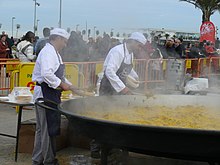
Competitions and records
It has become a custom at mass gatherings in the Valencia region (festivals, political campaigns, protests, etc.) to prepare enormous paellas, sometimes to win a place in the Guinness World Records book. Chefs use gargantuan paelleras for these events.
Valencia restaurateur Juan Galbis claims to have made the world's largest paella with help from a team of workers on 2 October 2001. This paella fed about 110,000 people, according to Galbis' former website. Galbis says this paella was even larger than his earlier world-record paella made on 8 March 1992, which fed about 100,000 people. Galbis' record-breaking 1992 paella is listed in Guinness World Records.
Alternative ingredients
Some non-Spanish chefs include chorizo in their paellas and other ingredients, which Valencian people believe do not belong in paella of any type. The alternative name proposed for these dishes, although pejorative, is arroz con cosas ('rice with things'). Famous cases are Jamie Oliver's paella recipe (which included chorizo) and Gordon Ramsay's. The author Josep Pla once noted: "The abuses committed in the name of Paella Valenciana are excessive – an absolute scandal."
However, in an article for El País, Spanish food writer Ana Vega 'Biscayenne', citing historical references, showed that traditional Valencian paella did indeed include chorizo, exclaiming, "Ah Jamie, we'll have to invite you to the Falles."
Emoji

In 2015, an emoji for paella was proposed to Unicode. The emoji was approved for Unicode 9.0 as U+1F958 "SHALLOW PAN OF FOOD" in June 2016. Apple Inc.'s version of the emoji originally depicted Paella de marisco, but was later changed to a more traditional appearance with chicken after online controversy.
Related dishes
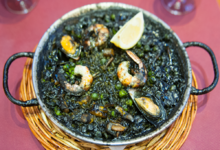
Traditional Valencian cuisine offers recipes similar to paella valenciana and paella de marisco such as arròs negre, arròs al forn, arròs a banda and arròs amb fesols i naps since rice is the base of much of the local cuisine.
Fideuà is a Valencian pasta noodle dish variation cooked similarly in a paella. It may be served with allioli sauce.
Other related dishes:
- Arroz del Senyoret – A seafood paella typical from Alicante, in which the seafood comes all peeled, so it is easier to eat. The name Senyoret translates as "little lord".
- Arroz con costra (Crusted rice), so named because it is covered with an egg crust.
- Arroz a la valenciana – Latin American and Filipino adaptation of the Valencian style of cooking rice, uses annatto instead of saffron
- Arroz con gandules – Latin American (Caribbean) adaptation
- Arroz con pollo – Latin American adaptation with chicken
- Bringhe – pre-colonial Filipino dish derived from biryani dishes but merged with paella during the colonial period. Uses glutinous rice, turmeric, and coconut milk.
- Jambalaya – Louisiana dish influenced by paella and the French jambalaia from Provence
- Locrio – Dominican descendant of paella.
- Paelya – Filipino adaptation of paella that distinctively use glutinous rice, also uses annatto, turmeric, or safflower. Also spelled "paella", but pronounced without .
See also
- Arroz a la valenciana
- Biryani
- Jambalaya
- List of rice dishes
- Mediterranean cuisine
- Paelya
- Pilaf
- Risotto
- Spanish rice
- Valencian cuisine
References
- "paella". Lexico UK English Dictionary. Oxford University Press. Archived from the original on 22 March 2020.
- "paella". Merriam-Webster's Collegiate Dictionary. Merriam-Webster, Inc. Retrieved 16 January 2022.
- Canela, Joan (24 September 2023). "La paella com a símbol d'identitat però també d'acollida". La Veu del País Valencià (in Catalan). Retrieved 2 March 2024.
... la paella és segurament el principal tret identitari que uneix (o no) els habitants d'aquest raconet del món entre el Sénia i el Segura.
[... paella is probably the main identity trait that unites (or not) the inhabitants of this corner of the world between the Cenia and Segura . (i.e. Valencians)] - Panadero, Amparo (11 March 2019). "La paella valenciana quiere ser Patrimonio de la Humanidad". Diario16 (in Spanish). Retrieved 19 February 2020.
En el caso de la paella valenciana, se trata de una tradición culinaria y social que constituye un icono de hospitalidad y un símbolo de unión e identidad valencianas ...
- ^ "Info about Paella on About.com". Spanishfood.about.com. 15 December 2009. Retrieved 19 February 2010.
- Vidal-González, P.; Medrano-Ábalos, P.; Sáez Álvarez, E.J. (March 2022). "A nightmare glocal discussion. What are the ingredients of Paella Valenciana?". International Journal of Gastronomy and Food Science. 27: 5. doi:10.1016/j.ijgfs.2021.100430.
Our study confirms the existence of 10 basic ingredients, which appear whenever it is cooked in the homes of the 277 towns and cities of the Province of Valencia, the origin of the recipe. Nine of them are used more than 90% of the times and the tenth, rabbit, is used in 89% of cases. These 10 ingredients are olive oil, saffron or substitute colouring, tomato, chicken, ferradura or flat green bean, lima beans (Phaseolus lunatus), rabbit, rice, salt and water.
- "Senia Rice". Retrieved 27 August 2021.
- Iker Morán (La Vanguardia): Por qué los jueves se sirve paella (o arroz) en los bares y restaurantes (in Spanish)
- Watson, Andrew (1983). Agricultural innovation in the early Islamic world. Cambridge University Press. ISBN 0-521-06883-5.
- ^ Olver, Lynne (16 September 2009). "The Food Timeline presents a history of paella". The Food Timeline. Retrieved 19 February 2010.
- Tom Jaine (1989). The Cooking Pot: Proceedings. Oxford Symposium. p. 104. ISBN 978-0-907325-42-0.
- March, Lourdes (1999), "Paella", in Davidson, Alan (ed.), The Oxford Companion to Food, Oxford: Oxford University Press, pp. 566–567, ISBN 0-19-211579-0
- "Merriam Webster's definition and etymology of the word paella". Retrieved 8 June 2012.
- ^ "Diccionari normatiu valencià". www.avl.gva.es. Retrieved 2 November 2019.
- ^ "Diccionario de la Real Academia Española's (DRAE) definition and etymology of Paella". Retrieved 11 October 2012.
- "El recipiente". Lapaella.net. Retrieved 19 February 2010.
- The Royal Spanish Academy's definition of "paellera". Buscon.rae.es. Retrieved on 5 October 2016.
- Coromines, Joan (1991–1997). Diccionario crítico etimológico castellano e hispánico (in Spanish). Vol. 4. Madrid: Gredos. entry paila. ISBN 978-84-249-0066-3.
En catalán, paralelamente al castellano, el vocablo existe en dos formas, autóctona y tomada del francés: la primera, padella, se oye todavia en los Pirineos (desde S. Juan de las Abadesas hasta el Alto Pallars y Ribagorza); la segunda, paella 'sartén', fué adaptada aqui a la terminación autóctona -ella, pero muestra su procedencia forastera en la caída de la -d-: es ya antigua y hoy está casi generalizada; de ahí se tomó el cast. paella , especializado en el sentido de 'arroz a la valenciana', así llamado porque se hace en una sartén mas o menos grande. Es inadmisible la explicación que se le ha dado alguna vez como forma dialectal valenciana, pues tal fenómeno fonético es muy moderno en Valencia.
- Origin of "poêle". Littre.org. Retrieved on 5 October 2016.
- "Etimologia : padella;". etimo.it.
- "Meaning of the Spanish word padilla". Spanishdict.com. Retrieved 19 February 2010.
- حكاية طبق - باإييلا / إسبانيا, archived from the original on 11 December 2021, retrieved 30 October 2019
- Ruiz, Ana (2007). Vibrant Andalusia: The Spice of Life in Southern Spain. Algora Publishing. ISBN 9780875865409.
- Webster, Jason (3 August 2010). Andalus: Unlocking The Secrets Of Moorish Spain. Transworld. ISBN 9781407094816.
- Guthrie, Shirley (1 August 2013). Arab Women in the Middle Ages: Private Lives and Public Roles. Saqi. ISBN 9780863567643.
- Richardson, Paul (21 August 2007). Late Dinner: Discovering the Food of Spain. Simon and Schuster. ISBN 9781416545392.
- Duhart, Frédéric; Medina, F. Xavier. Els espais socials de la paella: antropologia d'un plat camaleònic. Revista d'etnologia de Catalunya. p. 89.
- ^ "History and Origins of Paella". The Paella Company. Retrieved 16 March 2020.
- Manuel Vázquez Montalbán, La cocina de los mediterráneos, Ediciones B – Mexico
- "César Besó Portalés, Vicente Blasco Ibáñez y el Naturalismo, I.E.S. Clara Campoamor, Alaquás (Valencia)". Ucm.es. Retrieved 19 February 2010.
- Cloake, Felicity (18 August 2011). "How to cook the perfect paella". The Guardian. Retrieved 23 March 2022.
- Burgen, Stephen (22 March 2022). "Researchers in Valencia pinpoint unwritten rules of paella". The Guardian. Retrieved 23 March 2022.
- Andrews, Colman (25 September 1988). "FOOD : A Spanish Disposition : Forget the Myth That Seafood Is a Must Ingredient in an Authentic Paella". Los Angeles Times. Retrieved 23 March 2022.
- ^ Tu nombre. "Arroz SOS presents a history of paella". Arrozsos.com. Archived from the original on 25 January 2010. Retrieved 19 February 2010.
- "La verdadera paella tradicional de Valencia". Lobby Market. 25 April 2023. Retrieved 4 July 2023.
- Mario Batali's version of mixed paella with chorizo Oprah.com: Retrieved 30 June 2011
- Recipe courtesy Tyler Florence. "Foodnetwork's paella recipe with seafood, chicken, and chorizo". Foodnetwork.com. Retrieved 19 February 2010.
- "An assortment of paella recipes". Spain-recipes.com. Retrieved 19 February 2010.
- ALFONSO, CLARA (8 September 2022). "Receta de arroz del senyoret | La receta del fin de semana: arroz del senyoret con langostinos, rape y ajos tiernos". Las Provincias (in Spanish). Retrieved 16 July 2024.
- "Arros QD's Quique Dacosta on why paella will be the dish of the summer". Evening Standard. 5 June 2019. Retrieved 18 December 2019.
- Curtis, Nick (2 June 2019). "Michelin-starred chef Quique Dacosta on how to make the ultimate paella". The Telegraph. ISSN 0307-1235. Retrieved 18 December 2019.
- "Authentic Paella Valenciana as it is made in Valencia". paellarecipes.top. 15 August 2019. Retrieved 23 December 2019.
- Dacosta, Quique (6 August 2019). "My kitchen essential: I'd be lost without . . . my paella pan". www.ft.com. Archived from the original on 10 December 2022. Retrieved 14 February 2020.
- "Philippine Paella". 18 March 2019.
- "Arroz Valenciana Recipe". Pinoy Recipe At Iba Pa. Retrieved 13 August 2011.
- "Paellas gigantes – Catering y paellas para eventos – Comidas gigantes". Paellas Gigantes.
- "Galbis's 1992 record listed on the Guinness website". Guinnessworldrecords.com. Retrieved 19 February 2010.
- Oliver, Jamie. (16 September 2015) Chicken & chorizo paella | Rice Recipes. Jamie Oliver. Retrieved on 2016-10-05.
- "Jamie Oliver's paella recipe is panned online". BBC News. BBC. 30 October 2014. Retrieved 5 January 2016.
- Vega, Ana (2 March 2016). "Chefs que destrozan la comida española". El País (in Spanish). No. El Comidista. Retrieved 5 October 2016.
- Josep Pla. Catalan Cuisine, Revised Edition: Vivid Flavors From Spain's Mediterranean Coast.
- Vega, Ana (14 October 2016). "La paella sí llevaba chorizo". El País (in Spanish). No. El Comidista. Retrieved 13 June 2018.
- Gonzalez Capella, Antonio (1 February 2015). "ISO/IEC JTC 1/SC 2/WG 2 PROPOSAL SUMMARY FORM TO ACCOMPANY SUBMISSIONS FOR ADDITIONS TO THE REPERTOIRE OF ISO/IEC 10646 1" (PDF). Unicode. Archived (PDF) from the original on 20 March 2015. Retrieved 10 March 2017.
- Thompson, Rachel (12 April 2017). "Apple has just made a major change to the paella emoji". Mashable. Retrieved 3 November 2023.
- ""Arroces" from Alicante" (PDF).
- "Paella: 10 things you need to know to enjoy it as a local". 12 November 2020.
- Parfitt, Joshua (21 August 2019). "PAN-TASTIC: Elche cooks world's largest 'arroz con costra' in massive dish requiring 3kg of salt". Olive Press News Spain. Retrieved 18 July 2024.
- Dominican Cooking (26 December 2005). "Locrio de Pollo". Retrieved 18 March 2014.
- "Arroz Valenciana". Panlasang Pinoy Meaty Recipes. 7 March 2018. Retrieved 14 December 2018.
Further reading
- March, Lourdes (1985). El Libro De La Paella Y De Los Arroces. Madrid: Alianza. ISBN 8420601012.
- Ríos, Alicia and Lourdes March (1992). The Heritage of Spanish Cooking. New York: Random House. ISBN 0-679-41628-5.
| Valencian Community articles | ||
|---|---|---|
| History |  | |
| Languages |
| |
| Sports | ||
| Cuisine | ||
| Musical instruments and typical music | ||
| Traditions and feasts | ||
| Music festivals | ||
| Category | ||